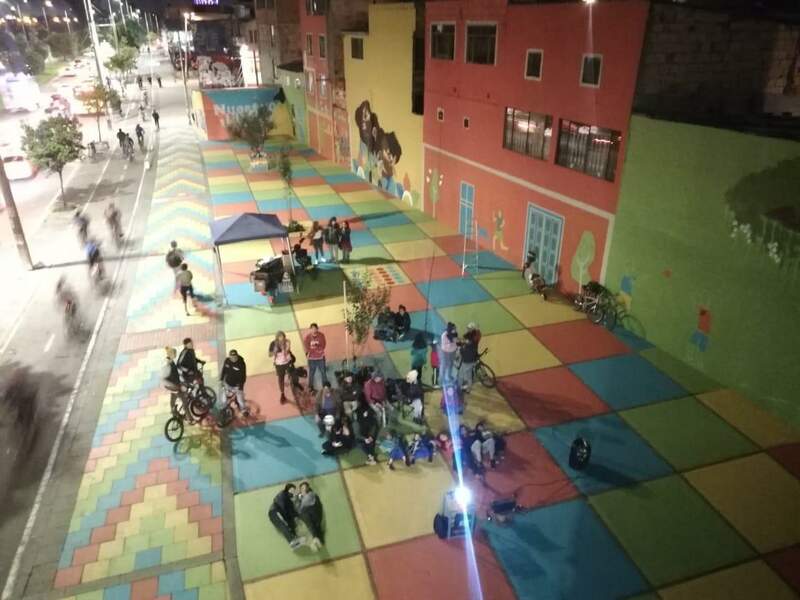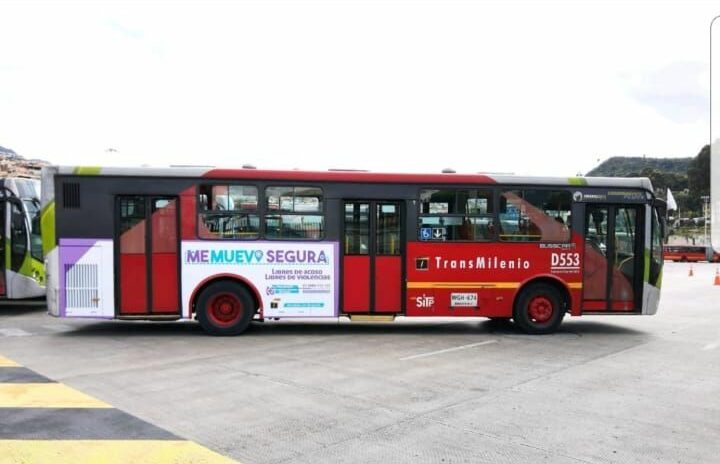Me Muevo Segura
In the Colombian capital Bogotá, fear of violence and sexual harassment is restricting the mobility of women, especially during the night. Therefore the project "Me Muevo Segura" aims to prevent this from happening.
In the Colombian capital Bogotá, fear of violence and sexual harassment is restricting the mobility of women, especially during the night. Therefore the project "Me Muevo Segura" aims to prevent this from happening.
 © SUTP
© SUTP The project “Me Muevo Segura” (I move safely) addressed the huge problem of Bogotá by mapping the complete street and cycle network of the city, implementing interventions in mass public transport as well as the redesign of public spaces to increase the comfort and security of women and girls.
In a participatory approach, this project successfully worked with different entities of government, civil society, and local communities. The data and insights collected provide an empirical basis for the City of Bogotá to target investments and programs to improve women’s safety. The tactical urbanism interventions have shown their transformative potential and are now in the process of replication, both locally and internationally.
Preparation for data collection:
Establishment of an independent project advisory board and consultation with other city entities
Tendering and subcontracting of experts and staff for data collection
Design of data collection strategy, development of questionnaires for interviews and training of staff
Data collection and analysis:
Data collection on street network: 13 vehicles for map ping of highways, arterial, intermediate and local roads.
Data collection on cycling network: 2 teams of 4 cyclists
Application of perception surveys with women at 47 SITP (bus) stops and 46 Transmilenio (BRT) stations.
Realization of 3 focus group discussions with female cyclists to collect qualitative data
Transmission of all mapping data to SafetiPin India for analysis and development of Nightly Safety Index.
Me Muevo Segura campaign and outreach:
Development of “Me Muevo Segura” toolkit with information on sexual harassment in public transport and response mechanism
Design and Implementation of a “Me Muevo Segura” campaign: awareness events in neighbourhoods, spots on radio & in social media, banners and information in Transmilenio stations, distribution of toolkit etc.
Organization of an international event to disseminate the project’s approach and results
Public Space recovery through Tactical Urbanism:
Identification of un-secure spaces through the Safety Index; coordination with local authorities
Participatory design and implementation of tactical urbanism interventions
Organization of social and cultural activities to animate the recovered spaces
Mediation between local communities and city entities
 © SUTP
© SUTP The main objective is to increase the safety of girls and women in Bogotá. Therefore they mapped the whole street and cycling network of the city and redesigned public spaces.
Bogotá is the first city in the world that mapped its complete street and cycling network and carried out georeferenced perception interviews:
The data collection provides a solid information basis to the city of Bogotá on the magnitude and geography of women‘s safety and security. With this data, the city can make targeted and strategic investment into street lighting, walkways and other improvements of public space and transport for more security.
The city appropriated the project for introduction of a safety and response protocol for harassment of women in public transport, along with the campaign “Me Muevo Segura”.
This project approach was disseminated to a large
group of Latin American leaders at an international
“Me Muevo Segura” seminar, which hosted more
than 170 city leaders and experts from Mexico, Chile, Ecuador, Brazil, Argentina, Perú and Costa Rica on November 28th of 2019.
The project leveraged funding from CAF to transform 5 precarious spaces into safe and comfortable places for women and children through tactical urbanism interventions and is coordinating the animation and maintenance of these spaces.
 © SUTP
© SUTP This project stands out for its innovative and sustainable approach that combines data collection, awareness-raising, community participation, and tactical urbanism to reduce violence and sexual harassment in Bogotá.
The project’s approach demands strong inter-institutional coordination in order to be successful: Activities had to be coordinated between different city entities (i.a. secretaries of women and mobility, police, local mayors, the authority of public space).
A similar data collection exercises require strong data management skills within public administration; otherwise, the data obtained cannot be properly interpreted or utilized.
The project needs political will and long-term commitment i.a. to ensure the long term maintenance of the tactical urbanism interventions.
The innovative approach, which was taken in Bogotá, showed significant success. Provided that the public administration and the involved institutions shave the dedication and are skilled in the field of data management, the approach can be replicated in cities in Latin America and other regions. Furthermore, the project can be scaled through additional funds for implementing tactical urbanism interventions to increase safety in the identified precarious spaces. Several Latin American municipalities have contacted the project partners with the interest of implementing a similar project in their cities.

Mechanical Engineer who immediately went into project management within the field of construction; having worked two years in USA and a further five years for GIZ in Africa focused on project implementation. After developing a strong focus on monitoring and controlling, he successfully began managing projects in the field of technical education and capacity building in Asia.
Focus Areas: TUMI Data, TUMI Labs, TUMI E-Bus MissionE-Mail Address:
info@transformative-mobility.orgYou need to load content from hCaptcha to submit the form. Please note that doing so will share data with third-party providers.
More InformationYou need to load content from reCAPTCHA to submit the form. Please note that doing so will share data with third-party providers.
More InformationYou are currently viewing a placeholder content from Turnstile. To access the actual content, click the button below. Please note that doing so will share data with third-party providers.
More Information